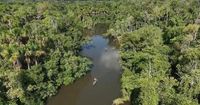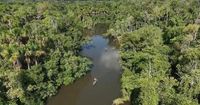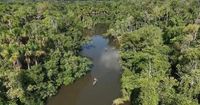High above the dense emerald canopy of the Amazon, invisible rivers of moisture glide westward, carrying life-giving rain from the Atlantic Ocean deep into South America. These “flying rivers,” as scientists call them, have long been the unsung heroes of the world’s largest rainforest, sustaining everything from jaguars and macaws to Indigenous communities and distant city lights powered by hydroelectric dams. But now, as deforestation and climate change intensify, these vital atmospheric currents are faltering—threatening to unleash a cascade of drought, fire, and instability across the continent and beyond.
On September 30, 2025, scientists sounded a fresh alarm: the flying rivers are weakening, and the consequences are already being felt. Droughts have shriveled crops in Peru, fires have raged through the Amazon, and Ecuador’s hydroelectric dams have struggled as rivers run dry, according to the Associated Press. A new analysis pinpoints southern Peru and northern Bolivia as especially vulnerable, raising concerns that these regions could tip from lush rainforest to dry savanna if current trends persist.
“These are the forces that actually create and sustain the Amazon rainforest,” said Matt Finer, a senior researcher with Amazon Conservation’s Monitoring of the Andean Amazon Project (MAAP), which tracks deforestation and climate threats across the basin. “If you break that pump by cutting down too much forest, the rains stop reaching where they need to go.”
So, what exactly are flying rivers? Most of the Amazon’s rainfall starts over the Atlantic Ocean, where moist air is pushed inland by steady trade winds blowing along the equator. The forest acts like a giant pump: trees absorb water through their roots, then release it as vapor through their leaves, relaying moisture thousands of miles westward. This process, as described by Brazilian climate scientist Carlos Nobre and his colleagues—who coined the term “flying rivers” during a 2006 scientific meeting—is what keeps the Amazon green and vibrant.
But relentless deforestation is disrupting this delicate system. The Amazon has already lost about 17% of its forest cover, mostly to cattle ranching and soy farming, according to Nobre. The loss of trees means less water vapor is carried westward, and the risk of drought rises—especially during the dry season, when the forest needs moisture the most. “It’s during the dry months, when the forest most needs water, that the flying rivers are most disrupted,” Finer told the Associated Press.
Nowhere is this disruption more evident than in southern Peru and northern Bolivia. During the dry season, flying rivers sweep across southern Brazil before reaching the Andes—precisely where deforestation is most intense, often spreading along highways and farms. The controversial BR-319 highway in Brazil, a project to pave a road through one of the last intact parts of the southern Amazon, could create a new front of tree loss and further destabilize the system. “Peru can do everything right to protect a place like Manu,” Finer explained, referring to the iconic Manu National Park. “But if deforestation keeps cutting into the pump in Brazil, the rains that sustain it may never arrive.”
The stakes are enormous. The Amazon rainforest isn’t just a regional treasure; it’s a vast storehouse for carbon dioxide, the main driver of global warming. If large parts of the forest tip into savanna, the world could lose a critical buffer against climate change, while wildlife, Indigenous communities, and global weather patterns all suffer. “If deforestation exceeds 20 to 25% and warming reaches 2 degrees Celsius, there’s no way to prevent the Amazon from reaching the tipping point,” Nobre warned. Already, the dry season is five weeks longer than it was 45 years ago, with 20 to 30% less rainfall, according to his research.
The human impacts are profound. Farmers in Peru face failed harvests, while Indigenous families struggle as fishing and hunting seasons grow unpredictable. Cities that depend on hydroelectric power have seen outages as the rivers that feed the dams dry up. “The last two years have brought the driest conditions the Amazon has ever seen,” said Corine Vriesendorp, director of science at Conservacion Amazonica in Cusco, Peru. “Ecological calendars that Indigenous communities use—when to plant, when to fish, when animals reproduce—are increasingly out of sync. Having less and more unpredictable rain will have an even bigger impact on their lives than climate change is already having.”
Scientists stress that the Amazon’s water cycle is fragile. In the wet season, flying rivers tend to flow over intact forests in Guyana, Suriname, and northern Brazil, keeping the system strong. But in the dry season, when forests are already stressed by heat, the aerial rivers cross southern Brazil, where deforestation is rampant. There, with fewer trees to help move moisture along, the system falters—especially in the very months when the forest most needs water.
For years, the specter of the Amazon reaching a tipping point—transforming from rainforest to savanna—has haunted scientists and policymakers alike. Finer emphasized that the process isn’t a sudden, all-at-once collapse. “Certain areas, like the southwest Amazon, are more vulnerable and will feel the impacts first. And we’re already seeing early signs of rainfall reduction downwind of deforested areas,” he said.
What can be done? Experts say the path forward is clear, if daunting. “To avoid collapse we need zero deforestation, degradation and fires—immediately,” Nobre urged. He called for large-scale forest restoration, not less than half a million square kilometers, and for global warming to be kept below 2 degrees Celsius. Supporting Indigenous land rights and protecting intact forests are also crucial steps, according to the Associated Press.
Finer suggested that governments consider new conservation categories specifically designed to protect flying rivers—not just the land beneath them, but the atmospheric flows that make the rainforest possible. Vriesendorp, meanwhile, praised Peru for creating vast parks and Indigenous reserves in the southeast, including Manu National Park. But she stressed the need for regional cooperation. “This can’t be solved by one country alone. Peru depends on Brazil, and Brazil depends on its neighbors. We need basin-wide solutions.”
The message from scientists is urgent: the Amazon’s fate hangs in the balance, and the weakening of its flying rivers is a warning sign that cannot be ignored. As the world watches, the choices made in the coming years—about forests, climate, and cooperation—will determine whether the Amazon remains a vibrant, rain-soaked wonder or slips into irreversible decline.






